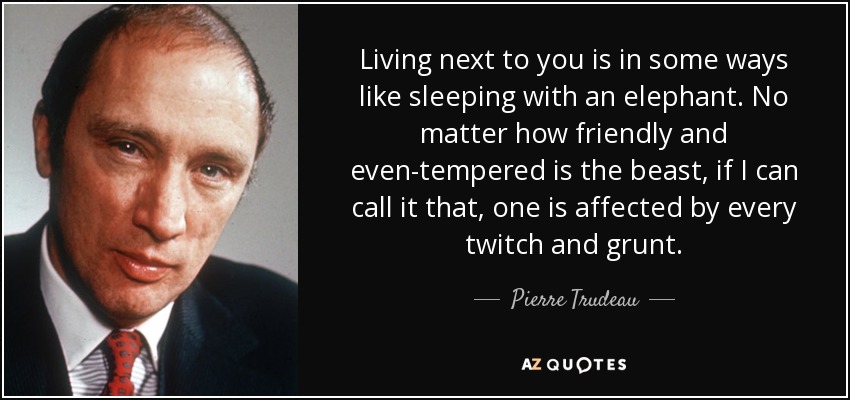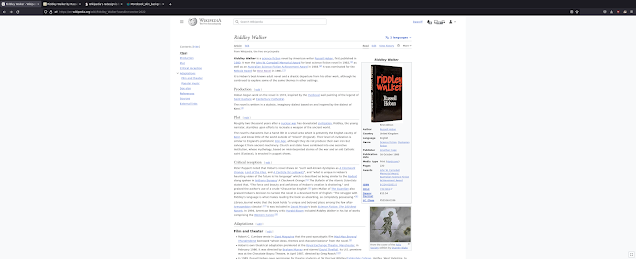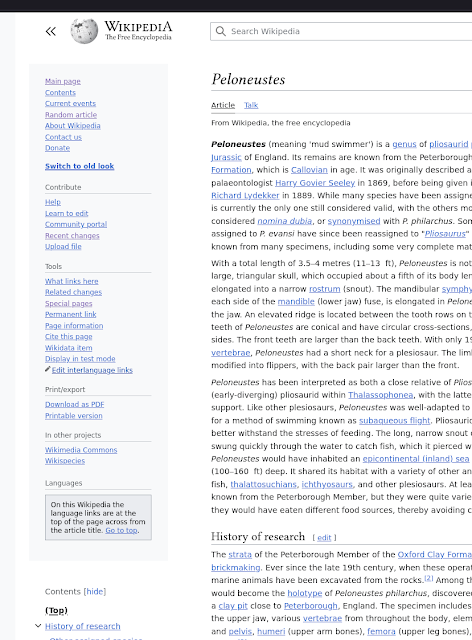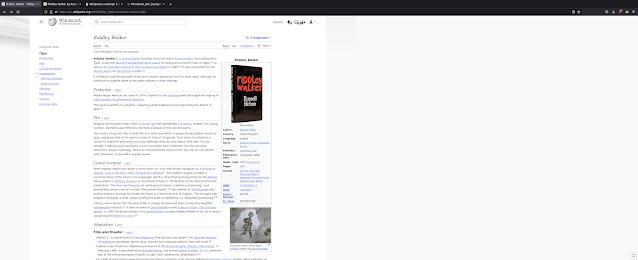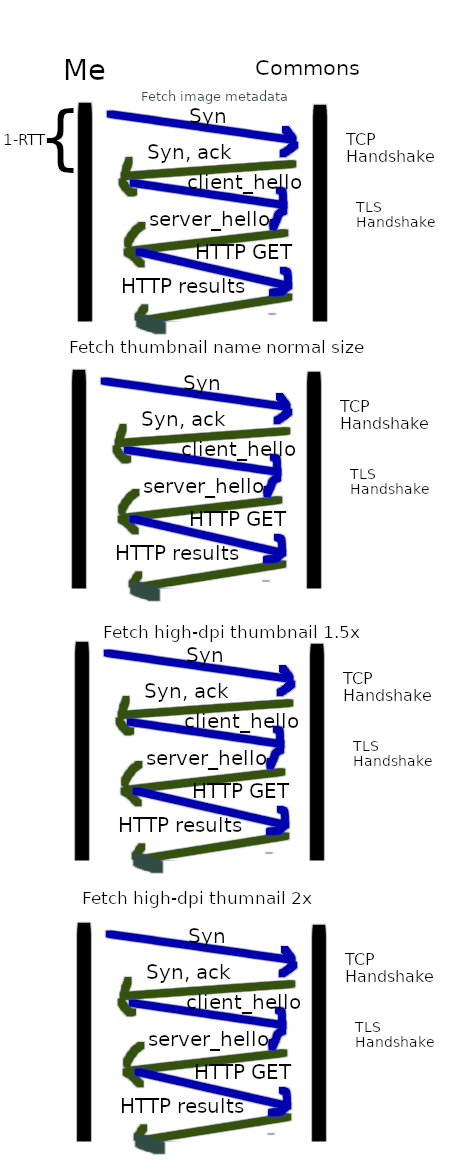As we roll into 2024, I thought I'd do something a little different on this blog.
A common product vision exercise is to ask someone, imagine it is 20 years from now, what would the product look like? What missing features would it have? What small (or large) annoyances would it no longer have?
I wanted to do that exercise with MediaWiki. Sometimes it feels like MediaWiki is a little static. Most of the core ideas were implemented a long time ago. Sure there is a constant stream of improvements, some quite important, but the core product has been fixed for quite some time now. People largely interact with MediaWiki the same way they always have. When I think of new fundamental features to MediaWiki, I think of things like Echo, Lua and VisualEditor, which can hardly be considered new at this point (In fairness, maybe DiscussionTools should count as a new fundamental feature, which is quite recent). Alternatively, I might think of things that are on the edges. Wikidata is a pretty big shift, but its a separate thing from the main experience and also over a decade old at this point.
I thought it would be fun to brainstorm some crazy ideas for new features of MediaWiki, primarily in the context of large sites like Wikipedia. I'd love to hear feedback on if these ideas are just so crazy they might work, or just crazy. Hopefully it inspires others to come up with their own crazy ideas.
What is MediaWiki to me?
Before I start, I suppose I should talk about what I think the goals of the MediaWiki platform is. What is the value that should be provided by MediaWiki as a product, particularly in the context of Wikimedia-type projects?
Often I hear Wikipedia described as a top 10 document hosting website combined with a medium scale social network. While I think there is some truth to that, I would divide it differently.
I see MediaWiki as aiming to serve 4 separate goals:
- A document authoring platform
- A document viewing platform (i.e. Some people just want to read the articles).
- A community management tool
- A tool to collect and disseminate knowledge
The first two are pretty obvious. MediaWiki has to support writing Wikipedia articles. MediaWiki has to support people reading Wikipedia articles. While I often think the difference between readers and editors is overstated (or perhaps counter-productive as hiding editing features from readers reduces our recruitment pool), it is true they are different audiences with different needs.
What I think is a bit under-appreciated sometimes but just as important, is that MediaWiki is not just about creating individual articles, it is about creating a place where a community of people dedicated to writing articles can thrive. This doesn't just happen at the scale of tens of thousands of people, all sorts of processes and bureaucracy is needed for such a large group to effectively work together. While not all of that is in MediaWiki, the bulk of it is.
One of my favourite things about the wiki-world, is it is a socio-technical system. The software does not prescribe specific ways of working, but gives users the tools to create community processes themselves. I think this is one of our biggest strengths, which we must not lose sight of. However we also shouldn't totally ignore this sector and assume the community is fine on its own - we should still be on the look out for better tools to allow the community to make better processes.
Last of all, MediaWiki aims to be a tool to aid in the collection and dissemination of knowledge¹. Wikimedia's mission statement is: "Imagine a world in which every single human being can freely share in the sum of all knowledge." No one site can do that alone, not even Wikipedia. We should aim to make it easy to transfer content between sites. If a 10 billion page treatise on Pokemon is inappropriate for Wikipedia, it should be easy for an interested party to set up there own site that can house knowledge that does not fit in existing sites. We should aim to empower people to do their own thing if Wikimedia is not the right venue. We do not have a monopoly on knowledge nor should we.
As anyone who has ever tried to copy a template from Wikipedia can tell you, making forks or splits from Wikipedia is easy in theory but hard in practice. In many ways I feel this is the area where we have most failed to meet the potential of MediaWiki.
With that in mind, here are my ideas for new fundamental features in MediaWiki:
As a document authoring/viewing platform
Interactivity
Detractors of Wikipedia have often criticized how text based it is. While there are certainly plenty of pictures to illustrate, Wikipedia has typically been pretty limited when it comes to more complex multimedia. This is especially true of interactive multimedia. While I don't have first hand experience, in the early days it was often negatively compared to Microsoft Encarta on that front.
We do have certain types of interactive content, such as videos, slippy maps and 3D models, but we don't really have any options for truly interactive content. For example, physics concepts might be better illustrated with "interactive" experiments, e.g. where you can push a pendulum with a mouse and watch what happens.
One of my favourite illustrations on the web is this one of an Enigma machine. The Enigma machine for those not familiar was a mechanical device used in world war 2 to encrypt secret messages. The interactive illustration shows how an inputted message goes through various wires and rotates various disks to give the scrambled output. I think this illustrates what an Enigma machine fundamentally is better than any static picture or even video would ever be able to.
Right now there are no satisfactory solutions on Wikipedia to make this kind of content. There was a previous effort to do something in the vein of interactive content in the graph extension, which allowed using the Vega domain specific language to make interactive graphs. I've previously wrote on how I think that was a good effort but ultimately missed the mark. In short, I believe it was too high level which caused it to lack the flexibility neccessarily to meet the needs of users, while also being difficult to build simplifying abstractions overtop.
I am a big believer that instead of making complicated projects that prescribe certain ways of doing things, it is better to make simpler, lower level tools that can be combined together in complex ways, as well as abstracted over so that users can make simple interfaces (Essentially the unix philosophy). On Wiki, I think this has been borne out by the success of using Lua scripting in templates. Lua is low level (relative to other wiki interfaces), but the users were able to use that to accomplish their goals without MediaWiki developers having to think about every possible thing they might want to do. Users were than able to make abstractions that hid the low level details in every day use.
To that end, what I'd like to see, is to extend Lua to the client side. Allow special lua interfaces that allow calling other lua functions on the client side (run by JS), in order to make parts of the wiki page scriptable while being viewed instead of just while being generated.
I did make some early proof-of-concepts in this direction, see https://bawolff.net/monstranto/index.php/Main_Page for a Demo of Extension:Monstranto. See also a longer piece I wrote, as well as an essay by Yurik on the subject I found inspiring.
Mobile editing
This is one where I don't really know what the answer is, but if I imagine MW in 20 years, I certainly hope this is better.
Its not just MediaWiki, I don't think any website really has authoring long text documents on mobile figured out.
That said, I have seen some interesting ideas around, that I think are worth exploring (None of these are my own ideas)
Paragraph or sentence level editing
This idea was originally proposed about 13 years ago by Jan Paul Posma. In fact, he write a whole bachelor's thesis on it.
In essence, Mobile gets more frustrating the longer the text you are editing is. MediaWiki often works on editing at the granularity of a section, but what about editing at the granularity of a paragraph or a sentence instead? Especially if you just want to fix a typo on mobile, I feel it would be much easier if you could just hit the edit button on a sentence instead of the entire section.
Even better, I suspect that parsoid makes this a lot easier to implement now than it would have been back in the day.
Better text editing UI (e.g. Eloquent)
A while ago I was linked to a very interesting article by Scott Jenson about the problems with text editing on mobile. I think he articulated the reasons it is frustrating very well, and also proposed a better UI which he called Eloquent. I highly recommend reading the article and seeing if it makes sense to you.
In many ways, we can't really do this, as this is an android level UI not something we control in the web app. Even if we did manage to make it in a web app somehow, it would probably be a hard sell to ordinary users not used to the new UI. Nonetheless, I think it would be incredibly beneficial to experiment with alternate UIs like these, and see how far we can get. The world is increasingly going mobile, and Wikipedia is increasingly getting left behind.
Alternative editing interfaces (e.g. voice)
Maybe traditional text editing is not the way of the future. Can we do something with voice control?
It seems like voice controlled IDEs are increasingly becoming a thing. For example, here is a blog post about someone who programs with a voice programming software called Talon. It seems like there are a couple other options out there. I see Serenade mentioned quite a bit.
A project in this space that looks especially interesting is cursorless. The demo looked really cool, and i could imagine that a power user would find it easier to use a system like this to edit large blobs of WikiText than the normal text editing interface on mobile. Anyways, i reccomend watching the demo video to see what you think.
All this is to say, I think we should look really hard at the possibilities in this space for editing MediaWiki from a phone. On screen keyboards are always going to suck, might as well look to other options.
As a community building platform
Extensibility
I think it would be really cool if we had "lua" extensions. Instead of normal php extensions, a user would be able to register/upload some lua code, that gets subscribed to hooks, and do stuff. In this vision, these extension types would not be able to do anything unsafe like raw html, but would be able to do all sorts of stuff that users normally use javascript for.
This could be per user or also global. Perhaps could be integrated with a permission system to control what they can and cannot do.
I'd also like to see a super stable API abstraction layer for these (and normal extensions). Right now our extension API is fairly unstable. I would love to see a simple abstraction layer with hard stability guarantees. It wouldn't replace the normal API entirely, but would allow simpler extensions to be written in such a way that they retain stability in the long term.
Workflows
I think we could do more to support user-created workflows. The Wiki is full of user created workflows and processes. Some are quite complex others simple. For example nominating an article for deletion or !voting in an RFC.
Sometimes the more complicated ones get turned into javascript wizards, but i think that's the wrong approach. As I side earlier, I am a fan of simpler tools that can be used by ordinary users, not complex tools that do a specific task but can only be edited by developers and exist "outside" the wiki.
There's already an extension in this area (not used by Wikimedia) called PageForms. This is in the vein of what I am imagining, but I think still too heavy. Another option in this space is the PageProperties extension which also doesn't really do what I am thinking of.
What I would really want to see is an extension of the existing InputBox/preload feature.
As it stands right now, when starting a new page or section, you can give a url parameter to preload some text as well as parameters to that text to replace $1 markers.
We also have the InputBox extension to provide a text box where you can put in the name of an article to create with specific text pre-loaded.
I'd like to extend this idea, to allow users to add arbitrary widgets² (form elements) to a page, and bind those widgets to specific parameters to be preloaded.
If further processing or complex logic is needed, perhaps an option to allow the new preloaded text to be pre-processed by a lua module. This would allow complex logic in how the page is edited based on the user's inputs. If there is one theme in this blog post, it is I wish lua could be used for more things on wiki.
I still imagine the user would be presented with a diff view and have to press save, in order to prevent shenanigans where users are tricked into doing something they don't intend to.
I believe this is a very light-weight solution that also gives the community a lot of flexibility to create custom workflows in the wiki that are simple for editors to participate in.
Querying, reporting and custom metadata
This is the big controversial one.
I believe that there should be a way for users to attach custom metadata to pages and do complex queries over that metadata (including aggregation). This is important both for organizing articles as well as organizing behind the scenes workflows.
In the broader MediaWiki ecosystem, this is usually provided by either the SemanticMediaWiki or Cargo extensions. Often in third party wikis this is considered MediaWiki's killer feature. People use them to create complex workflows including things like task trackers. In essence it turns MediaWiki into a no-code/low-code user programmable workflow designer.
Unfortunately, these extensions all scale poorly, preventing their use on Wikimedia. Essentially I dream of seeing the features provided by these extensions on Wikipedia.
The existing approaches are as follows:
- Vanilla MediaWiki: Category pages, and some query pages.
- This is extremely limited. Category pages allow an alphabetical list. Query pages allow some limited pre-defined maintenance lists like list of double redirects or longest articles. Despite these limitations, Wikipedia makes great use out of categories.
- Vanilla mediawiki + bots:
- This is essentially Wikipedia's approach to solving this problems. Have programs do queries offsite and put the results on a page. I find this to be a really unsatisfying solution. A Wikipedian once told me that every bot is just a hacky workaround to MediaWiki failing to meet its users' needs, and I tend to agree. Less ideologically, the main issue here is its very brittle - when bots break often nobody knows who has access to the code or how it can be fixed. Additionally, they often have significant latency for updates (If they run once a week, then the latency is 7 days) and ordinary users are not really empowered to create their own queries.
- Wikidata (including the WDQS SPARQL endpoint)
- Wikidata is adjacent to this problem, but not quite trying to solve it. It is more meant as a central clearinghouse for facts, not a way to do querying inside Wikipedia. That said Wikidata does have very powerful query features in the form of SPARQL. Sometimes these are copied into Wikipedia via bots. SPARQL of course has difficult to quantify performance characteristics that make it unsuitable for direct embedding into Wikipedia articles in the MediaWiki architecture. Perhaps it could be iframed, but that is far from being a full solution.
- SemanticMediaWiki
- This allows adding Semantic annotations to articles (i.e. Subject-verb-object type relations). It then allows querying using a custom semantic query language. The complexity of the query language make performance hard to reason about and it often scales poorly.
- Cargo
- This is very similar to SemanticMediaWiki, except it uses a relational paradigm instead of a semantic paradigm. Essentially users can define DB tables. Typically the workflow is template based, where a template is attached to a table, and specific parameters to the template are populated into the database. Users can then use (Sanitized) SQL queries to query these tables. The system uses an indexing strategy of adding one index for every attribute in the relation.
- DPL
- DPL is an extension to do complex querying and display using MediaWiki's built in metadata like categories. There are many different versions of this extension, but all of them have potential queries that scale linearly with the number of pages in the database, and sometimes even worse.
I believe none of these approaches really work for Wikipedia. They either do not support complex queries or allow too complex queries with unpredictable performance. I think the requirements are as follows:
- Good read scalability (By read, I mean scalability when generating pages (during "parse" in mediawiki speak). On Wikipedia, pages are read and regenerated a lot more often than they are edited.
- We want any sort of queries to have very low read latency. Having long pauses waiting for I/O during page parsing is bad in the MediaWiki architecture
- Queries should scale consistetly. They should at worse be roughly O(log n) in the number of pages on the wiki. If using a relational style database, we would want the number of rows the DBMS have to look at be no more than a fixed max number
- Eventual write consistency
- It is ok if it takes a few minutes for things using the custom metadata to update after it is written. Templates already have a delay for updating.
- That said, it should still be relatively quick. On the order of minutes ideally. If it takes a day or scales badly in terms of the size of the database, that would also be unacceptable.
- write performance does not have to scale quite as well as read performance, but should still scale reasonably well.
- Predictable performance.
- Users should not be able to do anything that negatively impacts site performance
- Users should not have to be an expert (or have any knowledge) in DB performance or SQL optimization.
- Limits should be predictable. Timeouts suck, they can vary depending on how much load the site is under and other factors. Queries should either work or not work. Their validity should not be run-time dependent. It should be obvious to the user if their query is an acceptable query before they try and run it. There should be clear rules about what the limits of the system are.
- Results should be usable for futher processing
- e.g. You should be able to use the result inside a lua module and format it in arbitrary ways
- [Ideally] Able to be isolated from the main database, shardable, etc.
- Be able to query for a specific page, a range of pages, or aggregates of pages (e.g. Count how many pages are in a range, average of some property, etc)
- Essentially we want just enough complexity to do interesting user defined queries, but not enough that the user is able to take any action that affects performance.
- There are some other query types that are more obscure but maybe harder. For example geographic related queries. I don't think we need to support that.
- Intersection queries are an interesting case, as they are often useful on wiki. Ideally we would support that too.
Given these constraints I think the CouchDB model might be the best match for on-wiki querying and reporting.
Much of the CouchDB marketing material is aimed around their local data eventual consistency replication story. Which is cool and all but not what I'm interested in here. A good starting point for how their data model works is their documentation on views. To be clear, I'm not neccesarily suggesting using CouchDB, just that its data model seems like a good match to the requirements.
CouchDB is essentially a document database based around the ideas of map-reduce. You can make views which are similar to an index on a virtual column in mysql. You can also make reduce functions which calculate some function over the view. The interesting part is that the reduce function is indexed in a tree fashion, so you can efficiently get the value of the function applied to any contiguous range of the rows in logrithmic time. This allows computing aggregations of the data very efficiently. Essentially all the read queries are very efficient. Potentially write queries can be less so but it is easy to build controls around that. Creating or editing reduce functions is expensive because it requires regenerating the index, but that is expected to be a rare operation and users can be informed that results may be unreliable until it completes.
In short, the way the CouchDB data model works as applied to MediaWiki could be as follows:
- There is an emit( relationName, key, data) function added to lua. In many ways this is very similar to adding a page to a category named relationName with a sortkey specificed by key. data is optional extra data associated with this item. For performance reason, there may be a (high) limit to the max number of emit() on a page to prevent DB size from exploding.
- Lua gets a function query( relationName, startKey, endKey ). This returns all pages between startKey and endKey and their associated data. If there are more than X (e.g. 200) number of pages, only return the first X.
- Lua gets a queryReduced( relationName, reducerName, startKey, endKey ) which returns the reduction function over the specified range. (Main limitation here is the reduce function output must be small in size in order to make this efficient)
- A way is added to associate a lua module as a reduce function. Adding or modifying these functions is potentially an expensive operation. However it is probably acceptable to the user that this takes some time
All the query types here are efficient. It is not as powerful as arbitrary SQL or semantic queries, but it is still quite powerful. It allows computing fairly arbitrary aggregation queries as well as returning results in a user-specified order. The main slow parts is when a reduction function is edited or added, which is similar to how a template used on very many pages can take a while to update. Emiting a new item may also be a little slower than reading since the reducers have to be updated up the tree (With possibly contention on the root node), however that is a much rarer operation, and users would likely see it as similar to current delays in updating templates.
I suspect such a system could also potentially support intersection queries with reasonable efficiency subject to a bunch of limitations.
All performance limitations are pretty easy for the user to understand. There is some max number of items that can be emit() from a page to prevent someone from emit()ing 1000 things per page. There is a max number of results that can be returned from a query to prevent querying the entire database, and a max number of queries allowed to be made from a page. The queries involve reading a limited number of rows, often sequential. The system could probably be sharded pretty easily if a lot of data ends up in the database.
I really do think this sort of query model provides the sweet spot of complex querying but predictable good performance and would be ideal for a MediaWiki site running at scale that wanted SMW style features.
As a knowledge collection tool
Wikipedia can't do everything. One thing I'd love to see is better integration between different MediaWiki servers to allow people to go to different places if their content doesn't fit in Wikipedia.
Template Modularity/packaging
Anyone who has ever tried to use Wikipedia templates on another wiki knows it is a painful process. Trying to find all the dependencies is a complex process, not to mention if it relies on WikiData or JsonConfig (Commons data: namespace)
The templates on a Wiki are not just user content, but complex technical systems. I wish we had a better systems for packaging and distributing them.
Even within the Wikimedia movement, there is often a call for global templates. A good idea certainly, but would be less critical if templates could be bundled up and shared. Even still, having distinct boundries around templates would probably make global templates easier than the current mess of dependencies.
I should note, that there are extensions already in this vein. For example Extension:Page_import and Extension:Data_transfer. All of them are nice and all, but I think it would maybe be cooler to have the concept of discrete template/module units on wiki, so that different components are organized together in a way that is easier to follow.
Easy forking
Freedom to fork is the freedom from which all others flow. In addition to providing an avenue for people who disagree with the status quo a way to do their own thing, easy forking/mirroring is critical when censorship is at play and people want to mirror Wikipedia somewhere we cannot normally reach. However running a wiki the size of english wikipedia is quite hard, even if you don't have any traffic. Simply importing an xml dump into a mysql DB can be a struggle at the sizes we are talking about.
I think it would be cool if we made ready to go sqlite db dumps. Perhaps possibly packaged as a phar archive with MediaWiki, so you could essentially just download a huge 100 GB file, plop it somewhere, and have a mirror/fork
Even better if it could integrate with EventStream to automatically keep things up to date.
Conclusion
So those are my crazy ideas for what I think is missing in MediaWiki (With an emphasis on the Wikipedia usecase and not the third party use-case). Agree? Disagree? Hate it? I'd love to know. Maybe you have your own crazy ideas. You should post them, after all, your crazy idea cannot become reality if you keep it to yourself!
Notes:
¹ I left out "Free", because as much as I believe in "Free Culture" I believe the free part is Wikimedia's mission but not MediaWiki's.
² To clarify, by widgets i mean buttons and text boxes. I do not mean widgets in the sense of the MediaWiki extension named "Widgets".


